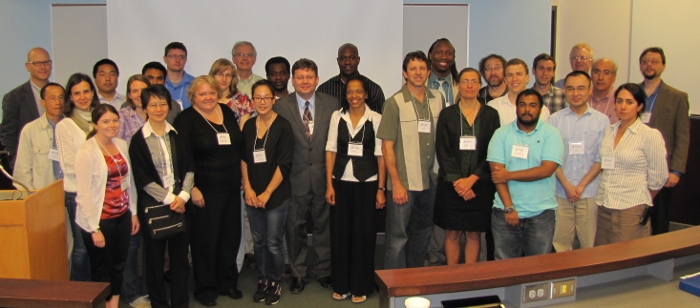| Description | Participants | Agenda | Products |
|---|
NIMBioS Investigative Workshop:
Modeling Blood Cell Interactions (MBCI)

Topic: Modeling blood cell interactions
Meeting dates: June 5-7, 2013
Organizers:
Damir B. Khismatullin, Dept. of Biomedical Engineering, Tulane Univ., New Orleans, LA
George Em Karniadakis, Division of Applied Mathematics, Brown Univ., Providence, RI
Konstantinos Konstantopoulos, Dept. of Chemical and Biomolecular Engineering, Johns Hopkins Univ., Baltimore, MD
Objectives:
The blood of human and other vertebrates contains a large number of individual, circulating cells. The interactions of these cells with each other and with the internal lining of blood vessels (vascular endothelium) are a key factor in maintaining body homeostasis, including adequate delivery of oxygen to body tissues, protection of the body against invading pathogens and defective cells, and plugging vascular wounds by blood clots. Mathematical modeling of the interactions of blood cells is a challenging, multifaceted, and multi-scale problem that can be appropriately solved only through integration of knowledge across several disciplines such as cell biology, physiology, biophysics, engineering, and mathematics. The Modeling Blood Cell Interactions (MBCI) workshop will bring together experts from these disciplines to share their recent progress in the investigation of blood cell interactions. MBCI will identify future directions in modeling of the collective dynamics of normal and sickle red blood cells, white blood cell-platelet-endothelial cell interactions, hematogenous metastasis of cancer, and activation and migration of adherent leukocytes and tumor cells.
Blood Cell Investigative Workshop WordPress site
Products
Publications
Fedosov DA, Gompper G. 2014. White blood cell margination in microcirculation. Soft Matter, 10: 2961-2970. [Online]
Li XJ, Peng ZL, Lei H, Dao M, Karniadakis, GE. 2014. Probing red blood cell mechanics, rheology and dynamics with a two-component multiscale model. Philosophical Transactions A, 372: 20130389. [Online]
NIMBioS Investigative Workshops focus on broad topics or a set of related topics, summarizing/synthesizing the state of the art and identifying future directions. Workshops have up to 35 participants. Organizers and key invited researchers make up half the participants; the remaining participants are filled through open application from the scientific community. Open applicants selected to attend are notified by NIMBioS within two weeks of the application deadline. Investigative Workshops have the potential for leading to one or more future Working Groups. Individuals with a strong interest in the topic, including post-docs and graduate students, are encouraged to apply. If needed, NIMBioS can provide support (travel, meals, lodging) for Workshop attendees, whether from a non-profit or for-profit organization.
A goal of NIMBioS is to enhance the cadre of researchers capable of interdisciplinary efforts across mathematics and biology. As part of this goal, NIMBioS is committed to promoting diversity in all its activities. Diversity is considered in all its aspects, social and scientific, including gender, ethnicity, scientific field, career stage, geography and type of home institution. Questions regarding diversity issues should be directed to diversity@nimbios.org. You can read more about our Diversity Plan on our NIMBioS Policies web page. The NIMBioS building is fully handicapped accessible.
NIMBioS
1122 Volunteer Blvd., Suite 106
University of Tennessee
Knoxville,
TN 37996-3410
PH: (865) 974-9334
FAX: (865) 974-9461
Contact NIMBioS


